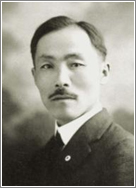This grade is represented by the addition of a green stripe to the student’s yellow belt. The foundation moves are starting to take root and new growth is appearing as the student becomes comfortable co-ordinating the movements. Do-San Hyong introduces the student to new techniques and new angles.
Pattern: Do-San Hyong – 24 Movements
도산

Do-San was the pseudonym of Ahn Chang Ho, a patriot of Korea who spent much of his life in the United States of America. He was born on Torong Island near Pyongyang (North Korea) in 1878 and at an early age established the first co-educational primary school in Korea. At the age of 24, he married Lee Hae-Ryon and moved to San Fransisco in order to get a western education and take more knowledge back to Korea. Along the way, as he passed by Hawaii, he saw the volcanic peaks and decided to adopt the name Do-San, meaning “Island Mountain” promising to stand tall against the turmoil in his homeland at that time. Finding the life of Koreans in the USA to be very poor he set about to improve their lives, becoming known as a leader in the Korean community and organising the Korean National Association. Upon returning to Korea in 1907 he established the New Peoples Association to promote Korean independence and nationalism in education and culture in the light of Japanese occupation of his homeland. He was forced to flee back to the USA in 1911 and the following decades were spent fighting for Korean national identity and the establishment of a Korean Provisional Government outside of Korea. He was arrested in China and deported back to Korea where he was imprisoned, finally dying on 10th March 1938. It is for all of this that he is honoured by Do-San Hyong.
24 Movements
The beginning position for Do-San Hyong is with feet shoulder width apart, fists in front of belt and looking straight ahead.
1. Move the left foot 90˚ left, into left forward stance and execute a left outer forearm block.
2. Maintain left forward stance and execute a right reverse mid-section punch.
3. Repeat these moves by moving the left foot first then the right foot turning 180˚ clockwise into right forward stance and execute a right outer forearm block.
4. Maintain right forward stance and execute a left reverse mid-section punch.
5. Next, move the left foot to your left into right back stance and execute a knife hand guarding block.
6. Step forward into right forward stance and execute a right spear-hand strike.
7. Twist the right hand counter-clockwise and pivot on the right foot turning completely around into left forward stance and execute a left high-section back-fist strike.
8. Step forward into right forward stance and execute a right high section back-fist strike.
9. Move the left foot, rotating counter-clockwise -90˚ into left forward stance, execute a left outer forearm block.
10. While maintaining a left forward stance, execute a right reverse mid-section punch.
11. Move the left foot first then the right foot turning 180˚ clockwise into right forward stance and execute a right outer forearm block.
12. Maintain right forward stance and execute a left reverse mid-section punch.
13. Move the left foot towards the right foot pivoting 135˚ counter-clockwise, then move into left forward stance and execute a wedging block with the forearms.
14. Then execute a right mid-section front kick.
15. Step down into right forward stance and execute a right mid-section punch.
16. Quickly follow up with a left mid-section reverse punch.
17. Move the right foot 90˚ to the right into right forward stance and execute a wedging block with the forearms.
18. Execute a left mid-section front kick.
19. Step down into left forward stance and execute a left mid-section punch.
20. Quickly follow up with a right mid-section reverse punch.
21. Move the left foot 45˚ left into left forward stance and execute a high-section block.
22. Step forward into right forward stance and execute a right high-section block.
23. Pivot on the right foot counter-clockwise 90˚ into horse riding-stance and execute a left knife-hand strike to the left side.
24. Finally, bring the left foot to the right then move the right foot into horse-riding stance and execute a right knife-hand strike to the right. (Kyup).
Finish: Bring the right foot back into ready stance.
Drills
Patterns teach us form and technique but also effective combinations for self defence purposes. Drills use the basic pattern movements taught through solo practice and apply them with a partner so as to teach practical applications under the stress of an ‘opponent’.
Unlike fighting, which can be compared at best to free sparring, self defence is about concluding the confrontation in the shortest and least violent manner in which the defender becomes the victor. Although not practising the pattern movements in their purest form, drills help us to be flexible within the framework of the pattern. Drills help us to practise the path of self defence rather than some competitive purity.
Drills begin with the hands in a non-aggressive protective position. In this version all 5 movements from the commencement of Do-San Hyung are used. The pattern teaches us to move to the left, blocking and counter punching. Here the target is the bicep muscle (or H2 if you know this vital point) which will cripple the attacking arm. If the attacker continues with their left punch, this is countered with moves 3 and 4 from Do-San. A final strike is used to finish the confrontation using the knife hand guarding “block”, movement 5.
In this version, the attacker has not thrown the second punch and therefore movements 3 and 4 of Do-San have been skipped. The transitional footwork of moving into back stance for movement 5 has been used to unbalance the attacker making it easier to deliver movement 5 to the neck of the attacker.
In this last version, the initial hay-maker punch was intercepted slightly earlier and further to the left. Thus movement 3, outer forearm “block” was applied to the neck of the attacker followed by reverse punch to the body. Again the foot sweep is used to unbalance and distract the attacker making the final movement more successful.

